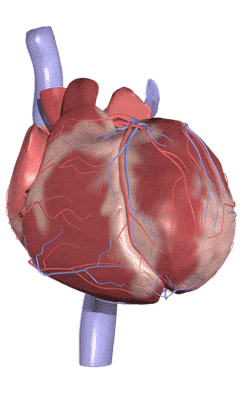The Heart - a double pump
 The four chambers of the heart
The four chambers of the heart
The heart is a double pump with four chambers, each separated by valves that only permit blood to flow in one direction. It pumps approximately five litres of blood round the body every minute, using energy at a rate of just a few watts.
- the right side of the heart pumps deoxygenated blood to the lungs
- the left side pumps oxygenated blood to the body.
The two sides of the heart are separated by a muscular wall called the septum.
The right upper chamber (atrium) takes in deoxygenated blood from the body and squeezes it into the right lower chamber (ventricle). From there, the blood is taken by an artery to the lungs, where the carbon dioxide is replaced with oxygen.
Oxygenated blood enters the heart's left upper chamber (atrium). It is then pumped into the lower left chamber (ventricle) and then into an artery (the aorta), where it starts its journey around the body again.
Blood pressure refers to the amount of force the pumping blood exerts on arterial walls.
 The heartbeat
The heartbeat
Valves ensure the blood passes one way only through the heart from each atrial chamber. Each atrium is connected to its ventricle by a one-way valve.
The valve on the right side of the heart is called the tricuspid valve, while the valve on the left side is called the mitral valve.
The familiar 'lub-dub' sound of the heartbeat is caused by the rhythmic closing of the heart valves as blood is pumped in and out of the chambers. The heart rate is regulated by a special cluster of cells situated in the right atrium, called the sinus node. This prompts the atria to contract first; then an electrical impulse is sent to a second node (the atrioventricular node), which is found between the atria and their ventricles. After a brief delay, the ventricles contract.
On average, the adult heart beats around 70 to 80 times every minute.


